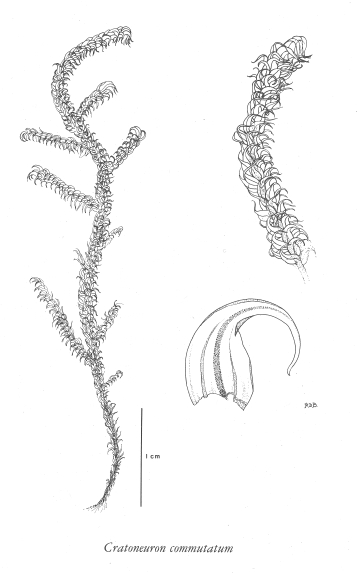Palustriella falcata (Hedw.)Roth
curled hook-moss
Amblystegiaceae
Species Account Author: Wilf Schofield
Extracted from Some Common Mosses of BC
Introduction to the Bryophytes of BC
curled hook-moss
Amblystegiaceae
Species Account Author: Wilf Schofield
Extracted from Some Common Mosses of BC
Introduction to the Bryophytes of BC
Species Information
Species description:
Genus name referring to the strong midrib of the leaf. Species name derived from the tendency of the plants to accumulate lime and form tufa that encrusts them.
Comments:
This species accumulates lime in hot-spring areas and also in some cold springs. Indeed, sometimes whole plants become encrusted and "petrified" with lime (tufa). Sometimes treated as Palustriella commutata.
Distinguishing characteristics:
This species, except on microscopic characters, closely resembles some species of Drepanocladus that grow in the same habitat. Microscopic examination, however, will expose the paraphyllia on the stem; these are absent in Drepanocladus. Paraphyllia are short, branched, hair-like structures on the stem, among the leaf bases. These can be seen on moist (not wet) material with a lOx hand lens. The leaves are markedly pleated, a feature shared by few mosses in this wet habitat.
Habit:
Forming turf-like mats of rich green to rusty, brownish-green to golden green; plants sometimes accumulating tufa; from sea level to subalpine elevations.
Similar Species:
Besides Drepanocladus, C. commutatum superficially resembles some species of Hypnum, but Hypnum has a double and obscure midrib, rather than a single obvious one, as in Cratoneuron. The pleated leaves and paraphyllia also separate Cratoneuron from Drepanocladus and Hypnum.
Illustration

If more than one illustration is available for a species (e.g., separate illustrations were provided for two subspecies) then links to the separate images will be provided below. Note that individual subspecies or varietal illustrations are not always available.
Illustration Source: Some Common Mosses of BC
Habitat and Range
Habitat
Swampy to seepage areas, especially calcium-rich areas; most frequent near lakes and watercourses but also abundant around springs and on wet cliffs. Range
World DistributionWidely distributed in the Northern Hemisphere. In North America, extending in the east, southward to Illinois; in the west to Colorado and California.
Status Information
Synonyms
Synonyms and Alternate Names:
Cratoneuron commutatum (Hedw.) G. Roth
Cratoneuron commutatum var. falcatum (Brid.) Mönk.
Cratoneuron williamsii Grout
Palustriella commutata (Brid.) Ochyra